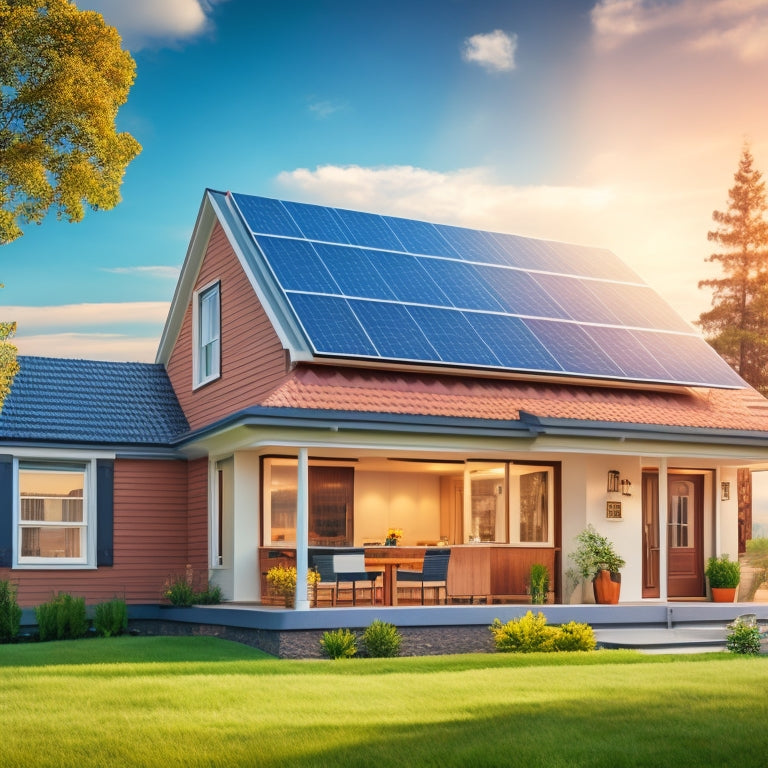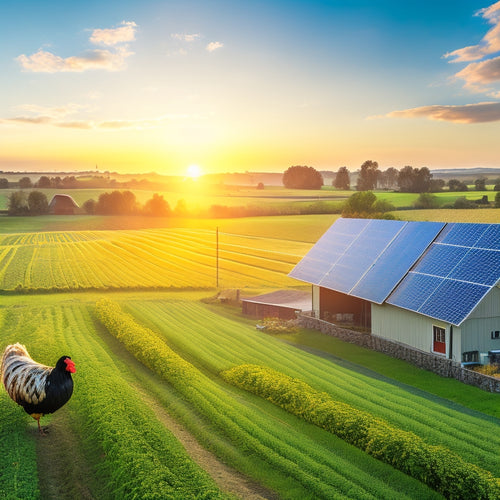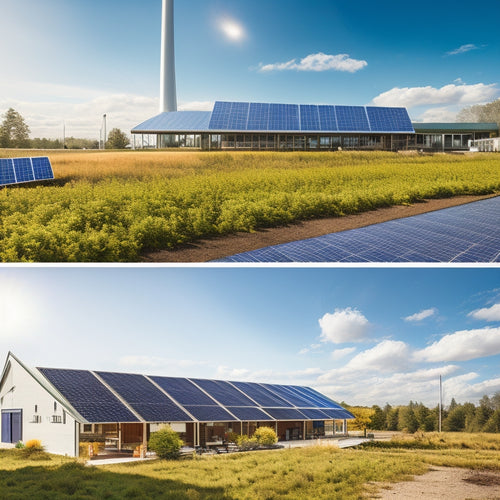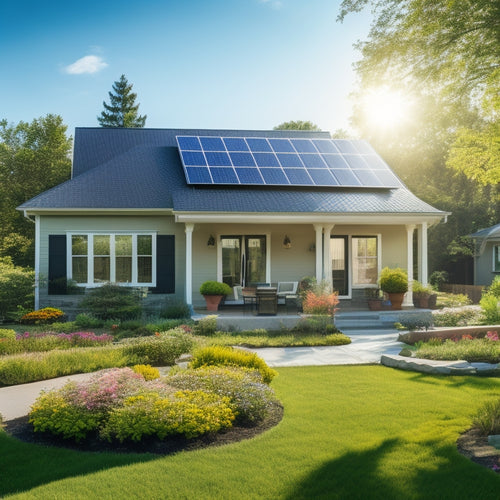
A Step-by-Step Guide to Solar Power Systems Prices
Share
You're evaluating a solar power system, and your primary concern is the cost. It's essential to understand that the price depends on several factors, including the type and quality of solar panels, system size, equipment, and installation costs. A 2-5 kW system, for instance, can cost between $8,000 and $20,000, while a larger 10-15 kW system can range from $25,000 to $60,000. Additionally, you'll need to take into account incentives, rebates, and ongoing maintenance expenses. By understanding these factors, you'll be able to make an informed decision about your solar power system. Now, it's time to get a clearer view of what you're investing in.
Key Takeaways
- System capacity, measured in watts, directly impacts the number of panels and equipment needed, with larger systems offering greater energy efficiency.
- Equipment and installation prices vary based on component quality and type, with high-efficiency solar panels and inverters generally costing more.
- Federal and state incentives, such as tax credits and rebates, can significantly reduce the upfront cost of a solar power system.
- Ongoing maintenance expenses, estimated at $1,000 to $3,000 over 25 years, can be minimized with regular inspections, cleaning, and monitoring.
- Researching and understanding local incentives, financing options, and utility programs can help maximize savings and offset energy costs.
Understanding Solar Panel Costs
Typically, a solar power system consists of several components, including solar panels, inverters, mounting hardware, and monitoring systems.
When examining solar panel costs, you'll want to focus on the type and quality of panels you choose, as they greatly impact the overall system's energy efficiency. There are three main solar panel types: monocrystalline, polycrystalline, and thin-film. Monocrystalline panels are the most efficient but also the most expensive, while polycrystalline panels offer a balance between efficiency and cost. Thin-film panels are the least expensive but also the least efficient.
You'll also want to evaluate the panel's wattage, which affects its energy production. Higher-wattage panels typically cost more but can generate more power. Additionally, look for panels with high energy efficiency ratings, usually expressed as a percentage. Higher efficiency ratings mean more energy production per unit area.
When assessing solar panel costs, be sure to factor in the warranty, durability, and maintenance requirements, as these can impact the system's overall performance and lifespan.
System Size and Price Factors
Your solar power system's size is a critical factor in determining its overall cost. The system capacity, measured in watts (W), directly affects the number of panels and equipment required, which in turn impacts the price. Generally, a larger system capacity results in a higher upfront cost, but it also leads to greater energy efficiency and savings in the long run.
To give you a better understanding, here is a breakdown of the system size and its corresponding price factors:
| System Capacity | Number of Panels | Price Range |
|---|---|---|
| 2-5 kW | 8-20 panels | $8,000-$20,000 |
| 5-10 kW | 20-40 panels | $15,000-$40,000 |
| 10-15 kW | 40-60 panels | $25,000-$60,000 |
As you can see, the larger the system capacity, the more panels you'll need, and the higher the price range. However, a larger system also means more energy efficiency and greater savings on your electricity bills. When determining the ideal system size for your needs, consider factors such as your energy consumption, available roof space, and local building codes.
Equipment and Installation Prices
The cost of solar power system equipment and installation varies widely depending on the quality and type of components used. You'll find that the prices of solar panels, inverters, and mounting systems can differ greatly between brands and models.
For instance, high-efficiency solar panels with a higher wattage output will generally cost more than lower-efficiency panels with a lower wattage output.
When it comes to solar inverter prices, you can expect to pay between $0.10 and $0.30 per watt, depending on the inverter's quality and features. A 5,000-watt inverter, for example, could cost anywhere from $500 to $1,500.
Additionally, if you're planning to install a battery storage system, you'll need to factor in the battery storage costs, which can range from $200 to $500 per kilowatt-hour.
The installation costs will also vary depending on the complexity of the installation, the location, and the installer's rates. On average, you can expect to pay between $2.50 and $3.50 per watt for installation, which translates to $12,500 to $17,500 for a 5,000-watt system.
Incentives and Rebate Options
Government incentives and rebate options can greatly reduce the upfront cost of your solar power system. As a homeowner, you're eligible for federal incentives, which include a 26% tax credit of the total system cost. This credit can be claimed on your tax return, reducing your taxable income.
Additionally, many states offer rebates and tax credits, further reducing the cost. For example, California offers a state tax credit of 10% of the system cost.
You can also investigate financing options, such as power purchase agreements (PPAs) and property assessed clean energy (PACE) financing, which allow you to install a solar power system with little to no upfront cost.
Utility programs, like net metering, also provide a way to offset your energy costs. By taking advantage of these incentives and rebates, you can enjoy the environmental benefits of solar power while reducing your energy expenses.
Be sure to research the specific incentives available in your area to maximize your savings.
Ongoing Maintenance Expenses
How much will you need to budget for ongoing maintenance expenses after installing your solar power system? While solar panels require minimal upkeep, some expenses will still arise. You can expect to spend around $1,000 to $3,000 over the system's 25-year lifespan.
Regular inspections and cleaning will guarantee peak performance. You may need to replace inverters, which can cost between $1,000 to $5,000, depending on the type and quality. Monitoring systems can help detect issues early, reducing repair costs.
Warranty coverage typically includes parts and labor for 10 to 25 years, depending on the manufacturer. However, you may need to pay for repairs or replacements outside of warranty periods.
It's crucial to factor these costs into your overall budget to avoid surprises down the line. To minimize expenses, consider partnering with a solar provider that offers maintenance and repair services.
Frequently Asked Questions
Can I Install Solar Panels on a Rented Property?
You'll need to negotiate renter agreements with your landlord to obtain installation permissions, ensuring you're both on the same page regarding solar panel installation, maintenance, and potential contract termination or property sale.
Do Solar Panels Work During a Power Outage?
You're likely aware that 70% of US households experience power outages each year; during these events, you'll need grid independence. With solar panels and battery storage, you can capture the sun's energy and maintain power, keeping your essentials running smoothly.
Are Solar Panels Recyclable at the End of Their Life?
You'll be glad to know that solar panels are recyclable, reducing their environmental impact. At the end of their life, you can recycle them, recovering up to 95% of materials like silicon, aluminum, and glass through solar panel recycling programs.
Can I Add More Panels to My Existing System Later?
You can expand your system later, but you'll need to guarantee panel compatibility; check your existing system's specifications and consider factors like voltage, current, and connector types to guarantee seamless system expansion.
Do Solar Panels Void My Roof's Warranty?
When you install solar panels, you're wondering if they'll void your roof's warranty. Typically, they won't, but you'll need to guarantee the installation meets your roof's warranty requirements, and that your installer follows the manufacturer's guidelines to avoid roof warranty implications.
Conclusion
You've made it to the end of your solar power expedition, and now you're ready to utilize the sun's energy to power your home. On one hand, the upfront costs may seem intimidating, but on the other hand, think of the long-term savings and environmental benefits. With the right system size, equipment, and installation, you'll be generating clean energy in no time. So, take a deep breath, crunch the numbers, and let the sun shine bright on your wallet!
Related Posts
-

Solar Power Advantages for Rural Communities
Solar power presents numerous advantages for rural communities. You can greatly reduce energy costs, potentially by u...
-

Off-Grid Solar Solutions for Eco-Conscious Businesses
Off-grid solar solutions offer you a path to both sustainability and substantial cost savings. By adopting these syst...
-

Affordable Solar Panels for Home Use
Affordable solar panels offer you a smart way to cut down on energy costs while promoting sustainability. With govern...


